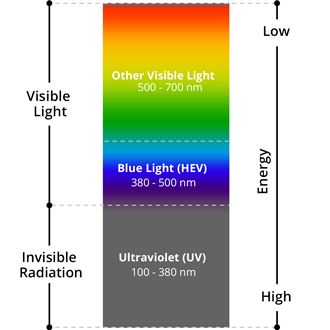How to Disable Blue Temperature Light on Summit Spr627os2d
Blue light: what you should know

Visible light is much more complex than you might think.
Stepping outdoors into sunlight; flipping on a light switch indoors; turning on your computer, phone or other digital device — all of these things result in your eyes being exposed to a variety of visible (and invisible) rays that can have a range of effects.
Most people are aware that sunlight contains visible light rays and also invisible ultraviolet rays that can tan or burn the skin. What many don't know is that the visible light emitted by the sun comprises a range of different-coloured light rays that contain different amounts of energy.
What is blue light?
Sunlight contains red, orange, yellow, green and blue light and many shades of each of these colours, depending on the energy and wavelength of the individual rays (also called electromagnetic radiation). Combined, this spectrum of coloured light rays creates what we call "white light" or sunlight.
The light spectrum
Without getting into complicated physics, there is an inverse relationship between the wavelength of light rays and the amount of energy they contain. Light rays that have relatively long wavelengths contain less energy, and those with short wavelengths have more energy.
Rays on the red end of the visible light spectrum have longer wavelengths and, therefore, less energy. Rays on the blue end of the spectrum have shorter wavelengths and more energy.
The electromagnetic rays just beyond the red end of the visible light spectrum are called infrared — they are warming, but invisible. (The "warming lamps" you see keeping food warm at your local restaurant emit infrared radiation. These lamps also emit visible red light so people know they are on! The same is true for other types of heat lamps.)
On the other end of the visible light spectrum, blue light rays with the shortest wavelengths (and highest energy) are sometimes called blue-violet or violet light. This is why the invisible electromagnetic rays just beyond the visible light spectrum are called ultraviolet (UV) radiation.
The perils and benefits of UV
UV rays have higher energy than visible light rays, which makes them capable of producing changes in the skin that create a suntan. Tanning beds used to emit a controlled amount of UV radiation specifically for this reason.
Too much exposure to UV causes painful sunburn or even worse can lead to skin cancer. These rays also can cause sunburned eyes a condition called photokeratitis or snow blindness.
Ultraviolet radiation, in moderation, also has beneficial effects, such as helping the body manufacture adequate amounts of vitamin D.
Generally, scientists say the visible light spectrum comprises electromagnetic radiation with wavelengths ranging from 400 nanometers (nm) on the blue end of the spectrum to about 700 nm on the red end. (By the way, a nanometre is one billionth of a metre — that's 0.000000001 metre!)
Blue light generally is defined as visible light ranging from 400 to 500 nm. Blue light sometimes is further broken down into blue-violet light (roughly 400 to 455 nm) and blue-turquoise light (roughly 465 to 495 nm).
So "blue" light, approximately one-third of all visible light, is considered high-energy visible (HEV).
Key points about blue light
Like ultraviolet radiation, visible blue light — the portion of the visible light spectrum with the shortest wavelengths and highest energy — has both benefits and dangers. Here are important things you should know about blue light:
1. Blue light is everywhere.
Sunlight is the main source of blue light, and being outdoors during daylight is where it is most prevalent. There are also many man-made, indoor sources of blue light, including fluorescent and LED lighting and flat-screen televisions.
Compared to older devices, the display screens of computers, electronic notebooks, smartphones and other digital devices emit higher amounts of blue light. However, the amount of HEV light these devices emit is only a small fraction of that emitted by the sun..
WORRIED ABOUT BLUE LIGHT? Find an optometrist near you.
2. HEV light rays make the sky look blue.
The short-wavelength, high-energy light rays on the blue end of the visible light spectrum scatter more easily than other visible light rays when they strike air and water molecules in the atmosphere. The higher degree of scattering of these rays is what makes a cloudless sky look blue.
3. The eye doesn't filter blue light.
Anterior structures of the adult human eye (the cornea and lens) are very effective at blocking UV rays from reaching the light-sensitive retina at the back of the eyeball. In fact, less than one percent of UV radiation from the sun reaches the retina, even if you aren't wearing sunglasses.
(Keep in mind, that sunglasses that block 100 percent of UV are essential to protect these and other parts of the eye from damage that could lead to cataracts, snow blindness, a pinguecula, pterygium, and even cancer.)
On the other hand, virtually all visible blue light passes through the cornea and lens and reaches the retina.
4. Blue light exposure may be a risk factor in macular degeneration.
The fact that blue light penetrates all the way to the retina (the inner lining of the back of the eye) is important, because laboratory studies have shown that exposure to blue light can damage light-sensitive cells in the retina. This causes changes that resemble those of macular degeneration, (AMD) which can lead to permanent vision loss.
Although more research is needed to determine how much blue light is "too much blue light" for the retina, many practitioners are concerned that for people at risk of AMD, blue light exposure outdoors might increase their chances of developing macular degeneration later in life.
Common risk factors include: a history of direct family members with AMD; smoking; poor diet and obesity; certain photosensitising medications and an outdoor occupation with higher sunlight exposure.
5. Blue light contributes to digital eye strain.
As short-wavelength, high energy blue light scatters more easily than other visible light, it is not as easily focused. When you're looking at computer screens and other digital devices that emit blue light, this unfocused visual "noise" reduces contrast and can contribute to digital eye strain.
Research has shown that lenses that block blue light with wavelengths less than 450 nm (blue-violet light) increase contrast. Therefore, glasses with appropriate blue filtering lenses may increase comfort when you're viewing digital devices for extended periods of time.
6. Blue light filtering may be important after cataract surgery.
The lens in the adult human eye blocks nearly 100 percent of the sun's UV rays. As part of the normal ageing process, the eye's natural lens eventually blocks some short-wavelength blue light as well.
If you have cataracts and are about to have cataract surgery, ask your surgeon what type of intraocular lens (IOL) will be used to replace your cloudy natural lens, and how much blue light filtering the IOL provides
7. Benefits of blue light.
It's well documented that some blue light exposure, particularly the wavelengths from 465 to 495nm, is essential for good health. Research has shown that high-energy visible light boosts alertness, helps memory and cognitive function and elevates mood.
In fact, something called light therapy is used to treat seasonal affective disorder (SAD) — a type of depression that's related to changes in seasons, with symptoms usually beginning in the autumn and continuing through winter. The light sources for this therapy emit bright white light that contains a higher amount of HEV blue light rays.
Blue light is also very important in regulating circadian rhythm — the body's natural sleep/awake cycle. Exposure to blue light during daytime hours helps maintain a healthful circadian rhythm but too much blue light late at night (reading a novel on a tablet computer for an hour or so at bedtime, for example) can disrupt this cycle, potentially reducing sleep quality and daytime fatigue. Blue light also helps control our pupil response to light.
Blue light filters
If you have one of more of the risk factors for developing AMD, when outdoors you can wear appropriate plano or prescription sunglasses or Transitions lenses.
Digital electronic devices emit blue light that can cause eye strain and may lead to eye problems over time.
These also give UV protection and reduce sun-glare. Wraparound sun-wear prevents side-on exposure which also helps prevent pterygia on the eye and even skin cancers on the delicate skin around the eyes. If you are concerned but don't wish to wear either sunglasses or Transitions lenses, clear lenses with an appropriate blue light filter can be prescribed by your optometrist.
If you are using your phone constantly — especially if you use it primarily for emailing and web browsing — a convenient way to increase contrast is to use a blue light filter.
These filters are available as apps or overlays for smartphones, tablets, and computer screens and reduce blue light from these devices without affecting the visibility of the display. Some are made with thin tempered glass that also protects your device's screen from scratches.
If you wear glasses there are a number of options to increase contrast by reducing blue light from digital devices. Whether you wear progressive lenses, specific computer glasses or just ordinary lenses there are blue filters available.
A number of lens manufacturers have introduced special anti-reflection coatings that also filter blue light for both sunlight and digital devices. You also may want to consider photochromic lenses, which filter blue light indoors and out and provide seamless protection from UV as they automatically darken in response to UV rays outdoors to increase comfort and reduce glare.
Ask your optometrist about which type of vision correction and lens features best suit your vision needs and if blue light filtering should be included.
Page published on Monday, 16 March 2020
Page updated on Saturday, 25 July 2020
Source: https://www.allaboutvision.com/en-au/digital-eye-strain/blue-light/
0 Response to "How to Disable Blue Temperature Light on Summit Spr627os2d"
Post a Comment